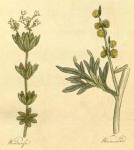Also see: The Wormseed Plant - Common Wormwood - Sea Wormwood - Roman Wormwood.
A wild plant frequent by way sides, and on ditch-banks. It is a yard high. The stalks are round, striated, white, firm, and branched. The leaves are large, but they are divided into a great number of small parts. They are of a pale whitish green, and stand irregularly on the stalks; many larger, but of the same kind, rise from the root. The flowers stand in a kind of loose spikes at the tops of the stalks; they are small and brown. The whole plant is of a very bitter taste.
The tops of the plant are to be used fresh gathered; a very slight infusion of them is excellent for all disorders of the stomach, and will prevent sickness after meals, and create an appetite; but if it be made strong, it will not only be disagree able to the taste, but will disgust the stomach.
The tops with the flowers on them dried and powdered, are good against agues, and have the same virtue with wormseed in killing worms; indeed they are much better than the wormseed that is commonly to be met with, which is generally too much decayed. The juice of the large leaves of wormwood, which grow from the root before the stalk appears, is good against the dropsy and jaundice, for it opens obstructions, and works by urine powerfully.


